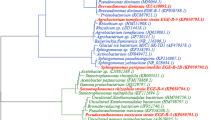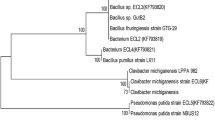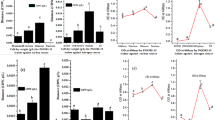Abstract
Endophytes are non-pathogenic microorganisms that reside within internal tissues of plant, without causing any apparent symptoms of infection. In an attempt to identify endophytes from Piper longum, the Indian long pepper, a combination of conventional and molecular approaches was used. Using culture-dependent approach, six different bacterial isolates were obtained from various surface-sterilized parts (roots, nodes, internodes, petioles, leaves and spikes) of the plant. In general, roots harboured maximum concentration of endophytic bacterial isolates, while leaves contained the minimum levels. These endophytes were analyzed on the basis of colony morphology and biochemical characteristics. Based on the results obtained after BLAST search of 16S rDNA sequence in NCBI database, the endophytes isolated from Piper longum showed highest similarity to Endophytic bacteria 135L-3, Enterobacter sp. SQ6-43, Bacillus casamancensis strain TN3, Alishewanella sp. JS-30, Bacterium B28 and Enterobacter ludwigii strain g45. Most of the identified bacteria belong to the phylum Proteobacteria and Firmicutes, whose members have been reported to act as growth-promoting bacteria in other plant species. Some of these endophytes tested positive for the ability to produce indole-3-acetic acid and hydrogen cyanide, suggesting their potential roles in plant growth promotion and biological control against pathogens, respectively.


Similar content being viewed by others
References
Bacon CW, White J (2000) Microbial endophytes. Marcel Dekker Inc, New York
Jia M, Chen L, Xin HL, Zheng CJ, Rahman K, Han T, Qin LP (2016) A friendly relationship between endophytic fungi and medicinal plants: a systematic review. Front Microbiol 7:906. https://doi.org/10.3389/fmicb.2016.00906
Leifert C, Cassells AC (2001) Microbial hazards in plant tissue and cell cultures. In Vitro Cell Dev Biol Plant 37:133–138
Richardson AE, Barea JM, McNeill AM, Prigent-Combaret C (2009) Acquisition of phosphorus and nitrogen in the rhizosphere and plant growth promotion by microorganisms. Plant Soil 321:305–339
deSanti Ferrara FI, Oliveira ZM, Gonzales HHS, Floh EIS, Barbosa HRB (2012) Endophytic and rhizospheric enterobacteria isolated from sugar cane have different potentials for producing plant growth-promoting substances. Plant Soil 353:409–417
Saravanakumar D, Lavanya N, Muthumeena B, Raguchander T, Suresh S, Samiyappan R (2008) Pseudomonas fluorescens enhances resistance and natural enemy population in rice plants against leaf folder pest. J Appl Entomol 132:469–479
Senthilkumar M, Swarnalakshmi K, Govindasamy V, Lee YK, Annapurna K (2009) Biocontrol potential of soybean bacterial endophytes against charcoal rot fungus, Rhizoctonia bataticola. Curr Microbiol 58:288–293
Stajner D, Kevresan S, Gasic O, Mimica-Dukic N, Zongli H (1997) Nitrogen and Azotobacter chroococcum enhance oxidative stress tolerance in sugar beet. Biol Plant 39:441–445
Stierle A, Strobel G, Stierle D (1993) Taxol and taxane production by Taxomyces andreanae, an endophytic fungus of Pacific yew. Science 260(5105):214–216
Brader G, Compant S, Mitter B, Trognitz F, Sessitsch A (2014) Metabolic potential of endophytic bacteria. Curr Opin Biotechnol 27:30–37
Gouda S, Das G, Sen SK, Shin HS, Patra JK (2016) Endophytes: a treasure house of bioactive compounds of medicinal importance. Front Microbiol 7:1538. https://doi.org/10.3389/fmicb.2016.01538
Rani D, Dantu PK (2012) Direct shoot regeneration from nodal, internodal and petiolar segments of Piper longum L. and in vitro conservation of indexed plantlets. Plant Cell Tissue Org 109:9–17
Aravind R, Kumar A, Eapen SJ, Ramana KV (2009) Endophytic bacterial flora in root and stem tissues of black pepper (Piper nigrum L.) genotype, isolation, identification and evaluation against Phytophthora capsici. Lett Appl Microbiol 48:58–64
Gram C (1884) Ueber die isolirte Farbung der Schizomyceten in Schnitt-und Trockenpraparaten. Fortschritte der Medicine 2:185–189
Graham PH, Parker CA (1964) Diagnostic features in the characterization of the root-nodule bacteria of legumes. Plant Soil 20:383–396
Dubey RC, Maheshwari DK (2012) Practical microbiology. S. Chand and Company Ltd, New Delhi
Adedayo O, Javadpour S, Taylor C, Anderson WA, Moo-Young M (2004) Decolourization and detoxification of methyl red by aerobic bacteria from a wastewater treatment plant. World J Microbiol Biotechnol 20:545–550
Gordon SA, Weber RP (1951) Colorimetric estimation of indoleacetic acid. Plant Physiol 26:192
Cappuccino JC, Sherman N (1992) Negative staining. In: Cappuccino JC, Sherman N (eds) Microbiology: a laboratory manual. Redwood City, CA, Benjamin, Cummings, pp 125–179
Lorck H (1948) Production of hydrocyanic acid by bacteria. Physiol Plant 1:142–146
O’Brien M, Colwell R (1988) Characterization tests for numerical taxonomy studies. In: Colwell RR, Grigorova R (eds) Met in microbiology, vol 19. Academic Press, Cambridge, pp 69–104
Cappucino JG (1983) Microbiology: a laboratory manual. Addison Wesley Publishing Company, Boston
Koser SA (1923) Utilization of the salts of organic acids by the colon-aerogenes group. J Bacteriol 8:493
Lindstrom K, Lehtomaki S (1988) Metabolic properties, maximum growth temperature and phage sensitivity of Rhizobium sp. (Galega) compared with other fast-growing rhizobia. FEMS Microbiol Lett 50:277–287
Kovacs N (1956) Identification of Pseudomonas pyocyanea by the oxidase reaction. Nature 178:703
Clarke PH, Cowman ST (1952) Biochemical methods for bacteriology. Microbiology 6:187–197
El Idrissi MM, Aujjar N, Belabed A, Dessaux Y, Filali-Maltouf A (1996) Characterization of Rhizobia isolated from Carob tree (Ceratonia siliqua). J Appl Bacteriol 80:165–173
Pelczar MJ, Reid RD (1965) Microbiology. McGraw-Hill, New York
Kersters K, Vancanneyt M (2005) Bergey’s manual of systematic bacteriology. Springer, Berlin
Nejad P, Johnson PA (2000) Endophytic bacteria induce growth promotion and wilt disease suppression in oilseed rape and tomato. Biol Control 18:208–215
Rijavec T, Lapanje A (2016) Hydrogen cyanide in the rhizosphere: not suppressing plant pathogens, but rather regulating availability of phosphate. Front Microbiol 7:1785. https://doi.org/10.3389/fmicb.2016.01785
Shoebitz M, Ribaudo CM, Pardo MA, Cantore ML, Ciampi L, Cura JA (2009) Plant growth promoting properties of a strain of Enterobacter ludwigii isolated from Lolium perenne rhizosphere. Soil Biol Biochem 41:1768–1774
Singh RP (2013) Isolation and characterization of multifarious plant growth promoting bacteria Enterobacter ludwigii PGP 19 isolated from pearl millet. Int J Sci Res 4:261–265
Vardhan S, Yadav AK, Pandey AK, Arora DK (2013) Diversity analysis of biocontrol Bacillus isolated from rhizospheric soil of rice–wheat (Oryza sativa–Triticum aestivum L.) at India. J Antibiot 66:485
Zheng XW, Yan Z, Nout R, Boekhout T, Han B, Zwietering MH, Smid EJ (2015) Characterization of the microbial community in different types of Daqu samples as revealed by 16S rRNA and 26S rRNA gene clone libraries. World J Microbiol Biotechnol 31:199–208
Pham VHT, Kim J (2012) Cultivation of unculturable soil bacteria. Trends Biotechnol 30:475–484
Acknowledgements
One of the authors wishes to acknowledge the University Grants Commission for non-SAP Fellowship. The authors also acknowledge the Director, Dayalbagh Educational Institute, for the financial support to carry out this work.
Author information
Authors and Affiliations
Corresponding author
Ethics declarations
Conflict of interest
The authors declare that they have no conflict of interest to publish this manuscript.
Additional information
Significance Statement
The endophytic bacteria of Piper longum have plant growth-promoting and biocontrol properties. Further studies in this direction would unravel their mode of transmission, co-evolution and bioprospecting for economically important compounds.
Rights and permissions
About this article
Cite this article
Mintoo, M.N., Mishra, S. & Dantu, P.K. Isolation and Characterization of Endophytic Bacteria from Piper longum. Proc. Natl. Acad. Sci., India, Sect. B Biol. Sci. 89, 1447–1454 (2019). https://doi.org/10.1007/s40011-018-01064-8
Received:
Revised:
Accepted:
Published:
Issue Date:
DOI: https://doi.org/10.1007/s40011-018-01064-8




